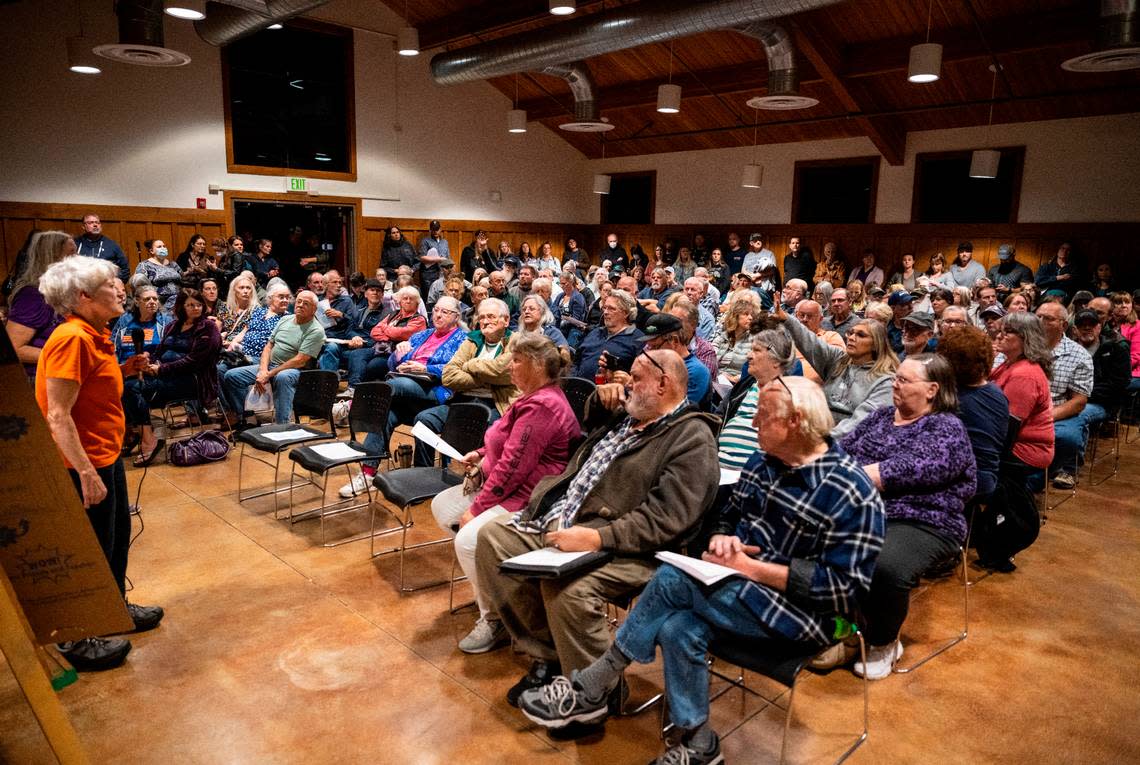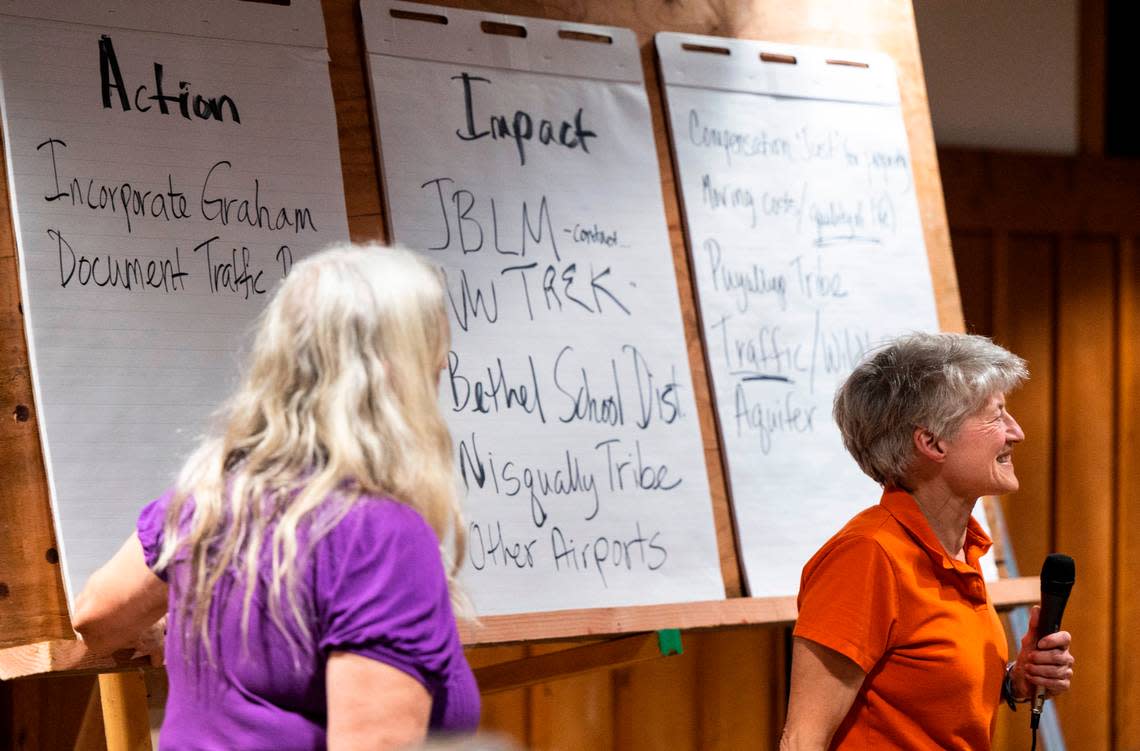A commercial airport in East Pierce County? These people are mobilizing to fight it
Shannon West, a veterinarian, is overwhelmed by the idea of losing her house and fearful that her neighbors could also be uprooted by a commercial airport expected to be operating in fewer than two decades.
When West, 67, learned that the Commercial Aviation Coordinating Commission was actively considering whether to recommend a two-runway airport be built somewhere within a six-mile diameter area encompassing her home in rural Graham, she took action.
West started the Facebook group, “Coalition Against Graham and Eatonville-Roy Airports,” which had amassed roughly 3,600 members as of Friday. She helped to order signs and send mailers. On Monday, she brought together an estimated 200 people, including at least 125 in person and more attendees via Zoom, to brainstorm how to shut down the airport’s local prospects.
“It was just one of those things,” West said after the meeting had wrapped. “We just did what needed to be done.”
West and others who came to the Frontier Park Lodge, where they mapped out an initial game plan on easel paper pads during an impassioned two-hour meeting, suggested the bulk of the work lies ahead of them. There are connections to make, protests to organize, lawmakers to mail, funds to raise, efforts to publicize and potentially a lobbyist to hire.
Residents in and around Graham, many of whom were dismayed by recently finding out about the airport deliberations, said they were concerned about losing their houses to make way for a large-scale potential project.
“It’s devastating,” said Arlene Murray-Adams, 65, who works as a veterans’ advocate. “It’s actually criminal that they would be able to even think about it.”
Even those outside the zone being considered for development were critical of such a facility’s fit for the area. Infrastructure is lacking, environmental burdens were too much and noisy flight operations capable of accommodating as many as 20 million annual passengers would greatly disrupt their rural lifestyle, they said.
“I would like to think that we can come up with a place that is — impacts less people to accomplish the task,” Russ Lafayette, 66, said.

Further study ahead before decision
The task sits in the laps of the CACC, a 15-voting member body of state, industry and community representatives, who were directed by state lawmakers three years ago to find a potential home for a new airport to be constructed and operational by 2040. In addition to domestic flight operations, the airport must be capable of handling cargo transport in order to reduce some of the growing pressure from an overburdened Seattle-Tacoma International Airport.
The directive to pick and recommend a site to the state Legislature by June 15, 2023 comes as the region is projected to see 27 million more annual passenger boardings than it can handle by 2050, and twice the current amount of cargo demand, according to a May 2021 study by the Puget Sound Regional Council.
In September, the CACC narrowed the number of so-called “greenfield” locations — a term used to describe undeveloped land — under consideration from 10 to three. The commission reaffirmed that decision this month. The sites that will be further studied into the spring include the “Pierce County East” location that has drawn anger and consternation from residents in Graham.
“Pierce County Central,” a site that the CCAC described as east of Roy and McKenna and just over two miles south of Joint Base Lewis-McChord, is another option. “Thurston County Central,” east of Olympia, is a third. The areas under review are also six-mile diameter zones. The airport could be roughly 3,100 acres, according to state consultant Kimley-Horn.
The CACC said it envisions an airport that uses an array of emission- and noise-reduction measures, and it recommended the state move forward on more environmentally friendly technologies by accelerating adoption of alternative aircraft propulsion systems and funding developments for sustainable aviation fuel, according to its report this month to the state.
The commission also recommended expanding Snohomish County Airport (Paine Field) and other airports in Washington looking to broaden regional air transportation service.
The CACC began holding semi-regular virtual public meetings or webinars in July 2020 and has held near monthly meetings since November. Now the focus is on engaging residents about its work and performing a technical analysis on the remaining greenfield site options, according to its October report, including cost estimates and airspace, environmental, infrastructure and transportation reviews.
It said it expects to further whittle down greenfield choices in the spring. The timeline adds pressure on airport opponents to be heard.

Opponents find support in council
Stephanie Torre Blanca, a state employee who lives near Graham, said she was concerned that the upcoming holiday season could cause delays in activism.
Airport opponents must seek immediately to further organize, solicit donations, rent billboards, translate informational material into non-English languages and take other meaningful action, she said, or “otherwise it’s going to be too late.”
For those who attended the recent meeting in Graham, such as Torre Blanca, an airport at either Pierce County site is neither desirable nor viable.
Richard Cummings, 78, who retired from the record business and Boeing, moved from the Seattle area to Graham a decade ago in hopes he had found his final home, which he noted provides views of pasture lands and Mount Rainier.
“And that would all be gone,” he said. “It’d just wipe it all out.”
Cummings said that such a major change would spur a level of traffic — which he called bad enough now — that could not be accommodated. He also questioned the environmental impacts and flights passing over JBLM.
Earlier this month, the Pierce County Council and County Executive Bruce Dammeier signed a letter to the state commission to strongly oppose any airport in the county, citing many of the same objections as residents did.
There are no plans to build the needed infrastructure or transit service in either “Pierce County East” or “Pierce County Central” areas, they said, and a development of the airport’s scope could pollute the Central Pierce County Aquifer, which is the main drinking water source for many communities.
County Council member Amy Cruver, whose district encompasses both sites being considered, attended Monday’s community meeting and left feeling “quite encouraged” by the turnout.
“It’s still really early in the game, or in the situation,” she said. “What’s most important, I think, is knowing how many people have this passion to stand up for their rights to protect their property. And it encourages me to know that I need to stay on top of it as well.”
Meanwhile, West said the next step is to direct energy into action items and dig into the details that will make the activists’ arguments more persuasive. She added that she wished she could address lawmakers in Olympia with slides of every home that would be affected, one by one.
“And show the Legislature what they would be destroying,” she said. “It’s not just hay fields.”
